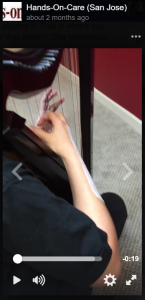At Hands-On-Care we treat our Musicians as Athletes
Musicians: Why do they develop repetitive stress injuries like tendonitis or carpal tunnel?
Let’s examine:
First rule of playing music is getting the set up correct. If it’s the piano, make sure the seat is the right height for the person playing it. If that is wrong, then everything will follow that pattern. The techniques the musician will learn will be incorrect, as they will play them with poor ergonomics for their body. The same applies to violin, guitar, harp, saxophone, etc.
The reason we say that musicians need to be viewed as athletes is because music is not played in short spurts – it’s an endurance game. To have the capacity to play, one must have just the right strength and endurance, along with flexibility in the muscles, to prevent injuries.
The reason we need strength and endurance is because the amount of load that is put on these muscles, big and small, needs to be less than what these muscles can handle so that they can take the load and not break down.
Musicians need to build their strength just like athletes, work on core strength to maintain proper posture, and build the endurance to sustain those postures.
So, it starts with core strength and building the proximal muscles to hold sustained position to allow for the distal coordination of muscles in order to be able to do the job without fatigue. Thus, working on postural muscles, rotator cuff muscles is of utmost importance.
Maintaining flexibility in all muscles helps to not tighten up during and after play, which can cause irritation and break down thus causing pain and inflammation. Flexibility exercises should be routine before and after performances. If aches and pain happen – stretch and apply ice.
Once ergonomics is correct, then check the technique. A lot of musicians are so into playing they fail to correct their techniques. We at Hands-On-Care use taping to provide proprioceptive input to correct the musician’s techniques and ergonomics of sitting / standing playing. Taping allows for self-correction while playing as it gives them feedback where they need to adjust to get the posture right. It can be done to the shoulder, elbow, wrist and even fingers.
Before After
Now after all that is done, we need the musician to be able to play with the right posture and technique for long duration. Assume that you have worked on their core strength, started work on their proximal muscles, yet they are shying away from playing for long duration or get fatigued when playing for a long duration and then their technique suffers. How do we build their Performance Endurance?
This is where the athletic training comes into play.
The musician, after their stretching exercises/warm up, starts to play with the necessary tapes to keep them in check. The musician times their instrument playing period, at the first sign of fatigue or pain the musician stops the timer and notates it. Next session they play the same piece but for less time than previously played, thus preventing any discomfort. Once comfortable with the time/piece played, they slowly start to increase the time played again without discomfort and notate the time. Slowly but surely the time is increased with all the pieces in place until musician achieves the skill without breaking down.
They must continue working out and building postural muscles, endurance, and cardio (since a lot of musicians have a sedentary posture, cardio helps to keep the metabolism high which helps with healing). Pre-warm ups flexibility exercises continue along with post stretching after playing. If they do hurt after playing, first assess what went wrong so that they won’t repeat the technique and then apply ice to calm the irritation down. Next time, practice the same piece with taping to correct it, until perfected.
I hope this gives you an idea why we treat our musicians as athletes.
All our musicians are required to bring in their instruments no matter how big (except piano). For Piano, we assess videos of them playing it.
We tape them while playing, educate them on taping, and then educate them on the program established for them
To seek assistance on developing a program for you or your kids, please contact us at 408-268-8536
Musicians injuries are covered by insurance, so contact your doctor for a prescription for therapy. In the unfortunate instance that you develop dystonia, we help with that as well. The sooner you seek help the better it gets.
Review: Read Alan D.‘s review of Hands On Care on Yelp“>CLICK HERE
Saba Kamal is a fantastic physical therapist. I am a musician who had radial tunnel release surgery performed by Dr. Gordon Brody with whom she works closely. Saba is knowledgeable, supportive, and extremely patient. I believe in her so much that I commuted nearly three hours several times a week to see her. An absolute pleasure to work with and should I have a future injury, I will look nowhere else but to Hands on Care!
Alan D, Fresno, CA

